Key highlights
- Follow this Cloudflare guide to understand what Cloudflare does and how it protects websites from DDoS attacks.
- Learn how Cloudflare works through its global network, caching and reverse proxy for faster delivery.
- Improve website performance with Cloudflare CDN, SSL certificate setup and load balancing.
- Explore free plan options, advanced security services and additional features for small businesses.
- Integrate Cloudflare APO with Bluehost WordPress hosting to enhance site speed and reliability.
The internet is faster, safer and more reliable today, thanks to Cloudflare. In this Cloudflare guide, we’ll explore how it powers millions of websites and servers worldwide.
If you’ve ever wondered what is Cloudflare or what does Cloudflare does, we have you covered. Cloudflare acts as a reverse proxy, improving site speed, website performance and security through its global network of data centers.
You’ll also learn what is Cloudflare used for: from blocking malicious traffic and DDoS attacks to delivering cached data faster through its content delivery network (CDN).
This Cloudflare guide will help you understand how does Cloudflare work, how it protects your origin server and why it’s one of the most cost-effective and secure solutions available today.
TL;DR
- Cloudflare speeds up websites and protects them from DDoS attacks through its global CDN and reverse proxy.
- It provides SSL encryption, DNS management and a powerful web application firewall for better security.
- Integrating Cloudflare APO with Bluehost WordPress hosting improves site speed and reliability.
- Setting up Cloudflare involves adding your site, updating nameservers and enabling Full (Strict) SSL.
- You can control caching, redirects and security using Cloudflare’s rule-based configuration.
- Cloudflare dashboards and logs help you monitor performance, block threats and fix DNS or SSL issues quickly.
What is Cloudflare?
Cloudflare is a web infrastructure and security company that improves website performance, speed and protection.
It provides a content delivery network (CDN), DNS service and security services, including DDoS protection and a web application firewall.
Cloudflare acts as a reverse proxy between users and the origin server, filtering malicious traffic and preventing DDoS attacks. By caching web content in global data centers, Cloudflare reduces latency and improves the internet experience for all websites.
It encrypts data with SSL certificates, secures domain names and ensures websites stay fast, reliable and secure.
What are the benefits of using Cloudflare for your website?
Cloudflare helps websites become faster, safer and more reliable. It combines the power of a content delivery network (CDN) with advanced security services.
- Better website performance: Cloudflare improves site speed by caching web content on data centers across its global network.
- Strong DDoS protection: It automatically detects and blocks DDoS attacks before they reach your origin server.
- Improved website security: Features such as SSL certificates, a web application firewall and malicious traffic filtering help keep your site secure.
- Reduced latency: Cloudflare’s load balancing and smart routing deliver faster delivery for websites worldwide.
- Easy scalability: Whether you run a personal blog or handle large enterprises, Cloudflare works seamlessly for all website owners.
These benefits make Cloudflare a vital tool for protecting your website, improving performance and ensuring a secure online experience.
How does Cloudflare work?
Cloudflare works as a reverse proxy between your visitors and your origin server.
It filters incoming traffic, blocks malicious activity and speeds up your website through global data centers.
Here’s a quick breakdown of how Cloudflare works:
1. Routes traffic through Cloudflare’s global network
- Every request passes through Cloudflare’s content delivery network (CDN).
- The global network spans 300+ cities worldwide, serving cached data close to visitors.
- This setup ensures faster delivery, reduced latency and a better internet experience.
Also read: What Is Global Server Load Balancing and Why It Matters
2. Acts as a reverse proxy for protection
- Cloudflare hides your origin server’s IP address to prevent attacks.
- It filters malicious bots, blocks many DDoS attacks and mitigates malicious traffic before it reaches your origin server.
- These security measures protect your web application and ensure your site stays secure.
3. Balances load and improves reliability
- Through load balancing, Cloudflare distributes requests across multiple servers for stability.
- It keeps websites online even under heavy web traffic or partial outages.
- This ensures consistent website performance for small businesses and large enterprises alike.
Also read: Load Balancing: Boost Website Speed & Avoid Downtime
4. Optimizes performance with caching
- Cloudflare stores web content and assets to speed up repeat visits.
- Cached websites load quickly without overloading your origin server.
- It improves site speed, DNS efficiency and overall website performance.
5. Secures communication with SSL and DNS
- Cloudflare provides SSL certificates to encrypt all DNS queries and user data.
- This protects your domain names and builds trust with visitors accessing your site.
In short, Cloudflare powers internet requests through intelligent routing, caching and protection, making your websites faster, safer and more reliable.
What are some unique features of Cloudflare?
Cloudflare offers a range of features designed to improve website performance, strengthen security and ensure reliability.
These features help websites load faster, block malicious traffic and deliver a safer experience for internet users worldwide.
1. APO for WordPress (edge HTML)
The Automatic Platform Optimization (APO) feature caches WordPress pages at Cloudflare’s network edge.
It stores cached data in nearby data centers, reducing the distance between your visitors and your origin server.
This helps lower latency, improve site speed and boost overall website performance through Cloudflare’s content delivery network (CDN).
We at Bluehost make APO integration simple for every WordPress site. Our platform works seamlessly with Cloudflare CDN, combining speed, security and reliability.
With Bluehost WordPress hosting, you get everything needed to maximize Cloudflare’s power:
What we offer:
- Free SSL certificate on eligible plans to keep every connection secure.
- Automatic WordPress updates to prevent vulnerabilities and reduce downtime.
- Optimized caching and HTTP/3 support for faster page loads and better performance.
- Built-in CDN configuration that works smoothly with Cloudflare’s global network.
- Expert assistance for DNS setup, nameserver changes and Full (Strict) SSL configuration.
- 24/7 customer support to help you maintain website performance and troubleshoot Cloudflare integrations.
When Bluehost and Cloudflare work together, your WordPress site gets faster delivery, stronger protection and a more stable global reach.
2. Turnstile (user-friendly CAPTCHA alternative)
Turnstile is Cloudflare’s privacy-first alternative to traditional CAPTCHA systems.
It verifies real users quietly in the background, blocking malicious bots without slowing down your site.
This keeps forms, logins and checkout pages secure while preserving a seamless user experience.
Also read: Add Cloudflare Turnstile CAPTCHA in WordPress: Complete Guide
3. Workers and KV/R2 (serverless at the edge)
Cloudflare Workers let developers run JavaScript code closer to visitors for minimal latency.
The KV and R2 storage solutions allow fast access to cached data stored across global data centers.
This developer platform makes it easy to build scalable, secure web applications without managing complex servers.
4. Zaraz (third-party tools without bloat)
Zaraz loads analytics, chat and marketing tools directly through the Cloudflare network instead of your website.
This reduces heavy scripts, lowers page load times and improves overall site speed.
By offloading tracking scripts, Zaraz helps websites stay fast, efficient and secure.
5. Zero Trust Access (no-VPN app security)
Cloudflare’s Zero Trust Access gives you control over who can access your internal web applications.
It authenticates users before granting entry, protecting your website from malicious bots and DDoS attacks.
This feature provides enterprise-grade security measures without requiring a traditional VPN.
Cloudflare’s combination of performance, reliability and built-in security tools empowers every website to stay protected, perform faster and serve visitors confidently.
Step-by-step guide to setting up Cloudflare
Setting up Cloudflare correctly ensures your website runs faster, stays secure and performs efficiently across its global network.
Follow these steps carefully to activate protection, caching and optimization for your website.
- Create a Cloudflare account and add your website
- Choose the right plan (Free, Pro or Business)
- Scan and import DNS records (A/AAAA, CNAME)
- Set proxy status per record (orange cloud vs DNS-only)
- Update domain nameservers to Cloudflare
- Verify nameserver change and DNS health
- Configure SSL/TLS mode (prefer Full (Strict) when possible)
- Enable HTTPS features (Auto HTTPS Rewrites, HSTS)
- Apply baseline caching & speed settings (cache rules, HTTP/3, Brotli, minify)
- Turn on core security protections (DDoS mitigation, Managed WAF, Bot Fight Mode)
Now, let’s look at these steps in detail.
1. Create a Cloudflare account and add your website
Go to Cloudflare.com, click “Sign Up” and create your account.
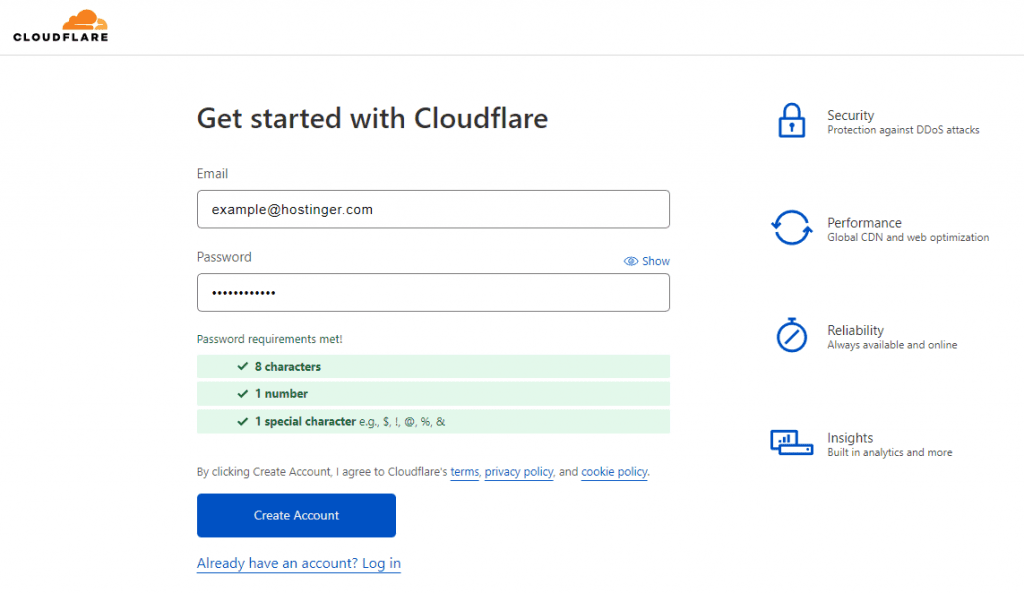
Click on “Create Account” or “Log in”, then click “Add Site” and enter your domain name.

Cloudflare will scan your existing DNS records and import most automatically.
2. Choose the right plan (Free, Pro or Business)
Once your site is added, Cloudflare asks you to select a plan.

For most websites, the Free plan is sufficient to get started.
Pro, Business and Enterprise plans offer advanced security services for high-traffic sites.
3. Scan and import DNS records (A/AAAA, CNAME)
Cloudflare lists A, AAAA and CNAME records it found.
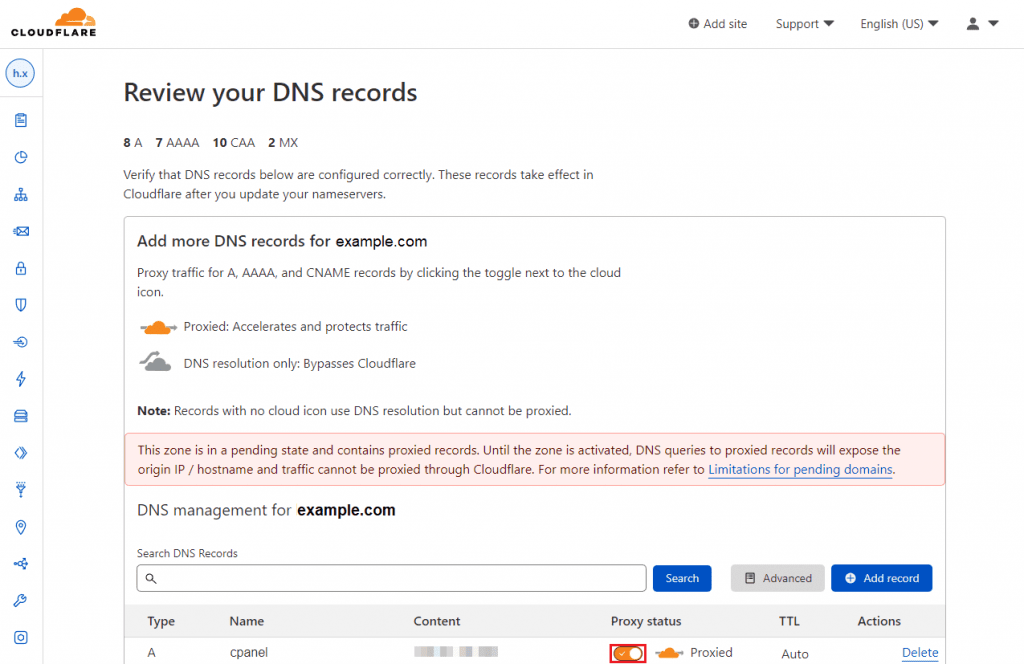
Review each entry and verify your IP addresses match your origin server.
Add or edit records if needed to ensure accuracy.
4. Set proxy status per record (orange cloud vs DNS-only)
In the DNS list, click the cloud icon to toggle proxy status.
Choose orange cloud (Proxied) for records you want routed through Cloudflare’s network.
Choose gray cloud (DNS-only) for services like email or FTP not need caching.
5. Update domain nameservers to Cloudflare
Cloudflare supplies two nameservers.
Log into your domain registrar, navigate to “Manage Nameservers” and replace them.
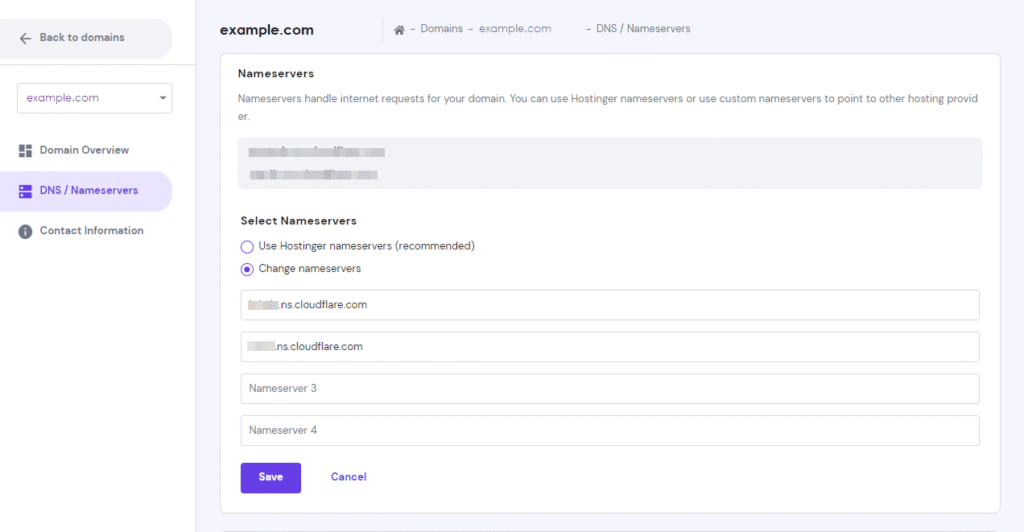
Click “Save” to update. This change activates Cloudflare’s DNS service.
6. Verify nameserver change and DNS health
Return to Cloudflare and click “Check Nameservers” to verify the update. DNS propagation may take up to 24–48 hours.

Use Cloudflare’s dashboard to confirm DNS health and active protection.
7. Configure SSL/TLS mode (prefer Full (Strict) when possible)
In Cloudflare, go to “SSL/TLS Settings” and select “Full (Strict)” mode.
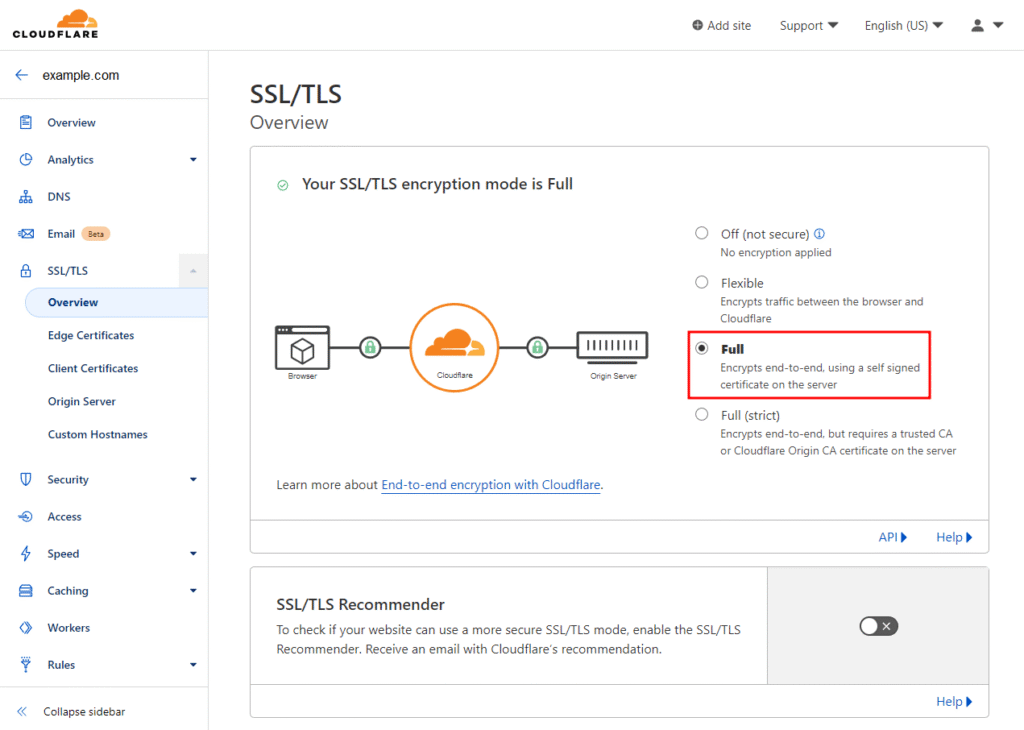
This encrypts traffic from the visitor to Cloudflare and from Cloudflare to your origin server.
Ensure your origin server has a valid SSL certificate for best security.
8. Enable HTTPS features (Auto HTTPS Rewrites, HSTS)
Under Edge Certificates, enable “Always Use HTTPS”, “Automatic HTTPS Rewrites” and HSTS.
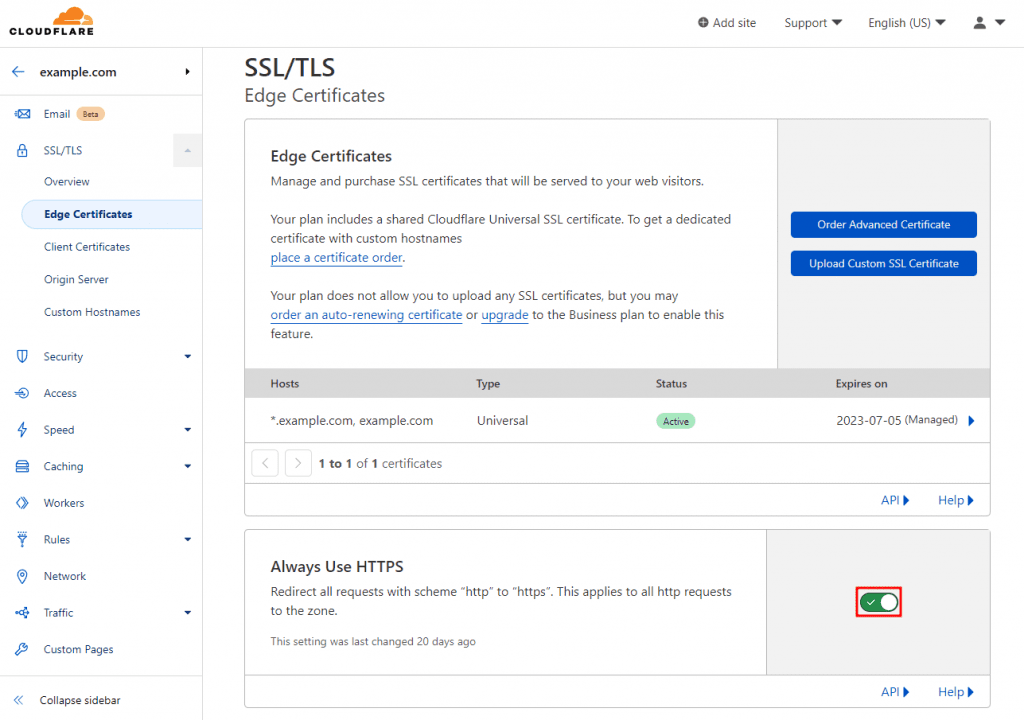
These features force secure links, improving site security, SEO and user trust.
They help maintain strong protection and improve website performance.
9. Apply baseline caching & speed settings (cache rules, HTTP/3, Brotli, minify)
Open the “Speed” or “Caching” tab. Enable HTTP/3, Brotli and Minify for HTML, CSS, JavaScript.
Go to “Cache Rules” and define static-asset caching.
These settings reduce load on your server and boost site speed via Cloudflare’s CDN.
Please note: Enabling minify may break some code; test first.
10. Turn on core security protections (DDoS mitigation, Managed WAF, Bot Fight Mode)
In the “Security” section, enable “Managed Web Application Firewall (WAF)”.
Consider enabling Bot Fight Mode to reduce some automated malicious traffic; monitor for false positives.
Cloudflare’s built-in DDoS mitigation protects your website and origin server from external threats.
How can I optimize performance with Cloudflare?
Cloudflare includes several built-in features that improve website speed, reduce latency and handle large volumes of traffic efficiently.
Here’s how you can optimize performance through caching, compression and intelligent network routing.
1. Cache rules and TTL strategy (static vs dynamic content)
Cloudflare’s caching system stores frequently used files, such as images, CSS and scripts, in nearby data centers.
When users visit your site, Cloudflare serves cached content from the closest location, improving site speed and reducing server load.
You can adjust cache behavior under “Rules” → “Cache Rules” and modify TTL (Time to Live) settings.
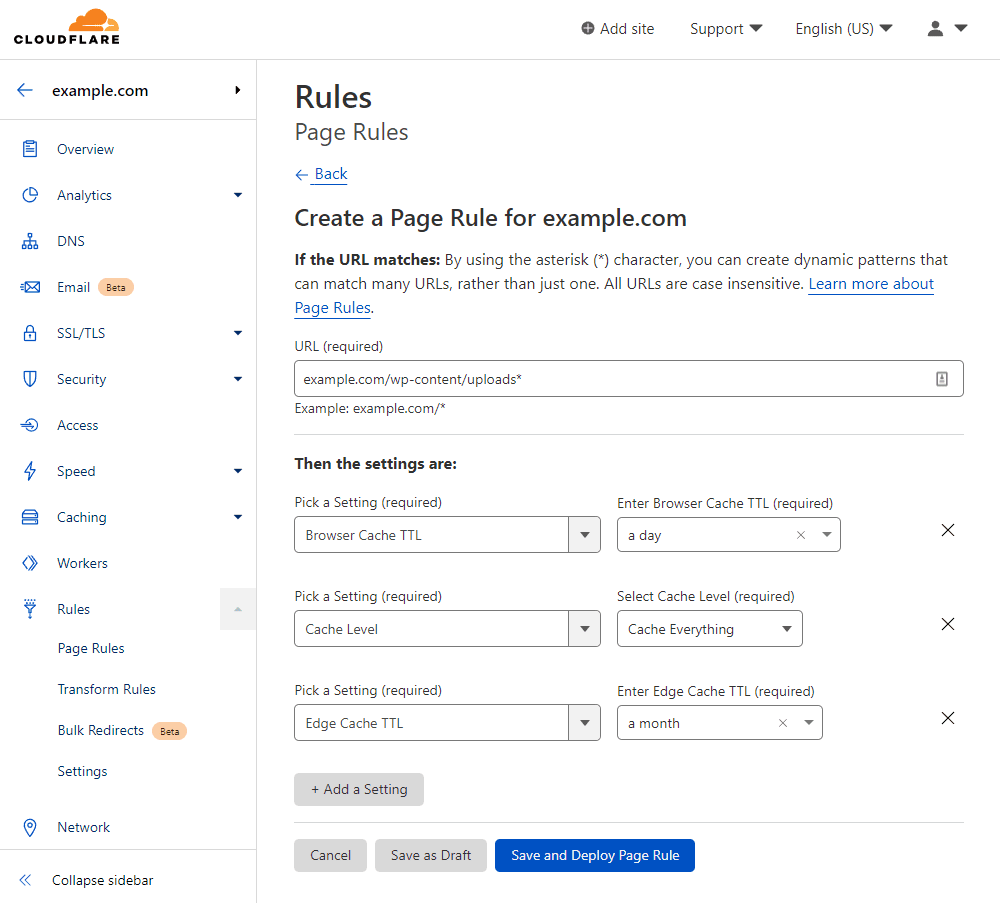
Keep static assets cached longer and set shorter intervals for dynamic pages.
This strategy enhances overall website performance while reducing bandwidth use and latency.
2. Image/script optimization and safe HTML caching
Under the “Speed” section, enable “Auto Minify” to compress HTML, CSS and JavaScript.
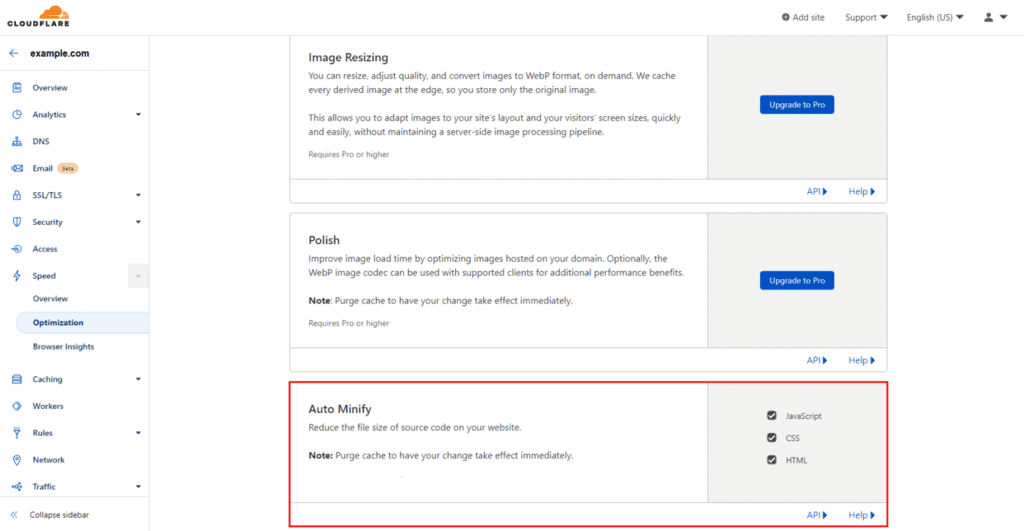
Use Cloudflare’s image optimization tools to shrink image sizes without losing quality.
This combination ensures faster delivery of web content through the content delivery network (CDN).
Cloudflare’s smart caching also helps safely store and serve HTML pages for faster repeat visits.
3. What should I measure? (TTFB, INP, LCP, cache hit ratio)
Tracking performance metrics is key to understanding how Cloudflare improves your site.
Use the dashboard to measure TTFB (Time to First Byte), INP (Interaction to Next Paint) and LCP (Largest Contentful Paint).
Check your cache hit ratio regularly; higher values indicate more data served from the cache.
These metrics help ensure your site continues to deliver a fast, consistent experience.
Cloudflare services also include load balancing, edge computing and Cloudflare Workers, which help manage millions of HTTP requests per day.
These advanced capabilities provide better internet access for global audiences by optimizing IP addresses and routing through its domain name system (DNS).
Whether you’re a small site or a large platform, Cloudflare protects, accelerates and helps your website stay ahead with secure and reliable delivery.
How do I secure my site with Cloudflare?
Cloudflare provides layered protection that defends websites from online attacks and unauthorized access.
By combining tools like the Web Application Firewall (WAF), rate limiting and origin protection, you can ensure a safe, stable and secure environment for visitors.
1. Fine-tune Managed WAF (testing and exclusions)
Cloudflare’s Managed WAF filters out malicious traffic before it reaches your server.
It detects threats automatically and lets you adjust sensitivity to avoid blocking legitimate users.
- Enable and customize the WAF: Turn on Cloudflare’s firewall to block SQL injection, cross-site scripting and spam requests instantly.
- Use Simulate mode for testing: Test rules safely in “Simulate” mode to assess impact before full deployment.
- Whitelist safe URLs or IPs: Add trusted addresses to the exclusion list to prevent false positives and keep pages accessible.
2. Rate limit sensitive routes (logins, APIs, search)
Rate limiting helps control how often users or bots can access critical parts of your website.
It’s essential for preventing brute-force attacks and maintaining smooth performance during heavy traffic.
- Set limits on critical pages: Define request caps for login, search or API routes to block repeated failed attempts.
- Protect DNS and origin resources: Rate limiting reduces excessive traffic that can overwhelm your domain name system (DNS).
- Monitor and adjust thresholds: Review analytics regularly and fine-tune settings based on real traffic patterns.
3. Protect the origin (lock down real server IP, allowlists)
Your origin server is the backbone of your website, and protecting it ensures long-term stability.
Cloudflare hides your real server’s IP and filters every connection for safety.
- Hide the server’s true IP: Use Cloudflare’s reverse proxy to mask your IP addresses and block direct targeting.
- Allow traffic only from Cloudflare: Configure your hosting or firewall to accept requests only from Cloudflare’s trusted IP ranges.
- Add allowlists for trusted access: Grant secure access to specific IPs or services that need direct connections.
These combined protections help you stay ahead of threats while delivering a reliable, safe experience for every visitor.
Also read: Website Security 101: Easy Steps to Protect Your Site from Cyber Threats
How can I control traffic and behavior with rules?
Cloudflare gives website owners advanced control over how traffic flows through their sites.
By setting up rules, you can manage redirects, caching and security policies, ensuring your website performs efficiently and stays secure.
These rules help website owners customize behavior across multiple servers and handle varying traffic patterns smoothly.
1. Redirect Rules and Transform Rules (modern alternative to Page Rules)
Redirect Rules and Transform Rules replace Cloudflare’s older Page Rules system.
They allow you to manage URL redirects, header rewrites and request modifications more efficiently.
- Simplify URL management: Use Redirect Rules to guide users from old URLs to new ones without breaking links.
- Improve SEO and structure: Transform URLs, remove trailing slashes or rewrite paths to make your domain easier to navigate.
- Control headers and parameters: Add or modify headers to improve site speed, content delivery and web application security.
These settings make it easy to handle millions of HTTP requests per day while maintaining a seamless experience for visitors.
2. Starter security and cache rule patterns
Security and caching rules ensure Cloudflare services deliver the right balance of performance and protection.
They help websites reduce load on origin servers while keeping malicious traffic out.
- Create basic cache rules: Cache static content like images or scripts while keeping dynamic pages fresh.
- Protect sensitive endpoints: Exclude login or admin paths from caching for accurate session handling.
- Combine security logic: Apply rate limiting and WAF filters together to block unwanted bots efficiently.
These caching strategies support better internet performance and help your site stay ahead of threats and slowdowns.
3. Header and cookie transformations (security headers, cache keys)
Header and cookie transformations fine-tune how browsers and Cloudflare handle your web content.
They play a key role in improving performance, securing sessions and organizing cache responses.
- Set security headers: Use headers like HSTS and X-Frame-Options to provide security and prevent clickjacking.
- Adjust cache keys: Customize them to store page variations without duplication or slow delivery.
- Manage cookies: Control cookie behavior to ensure faster delivery and better privacy compliance.
These flexible options allow website owners to optimize content delivery and maintain a safe, consistent experience for visitors.
Also read: Website Performance: Handling High Website Traffic
How should I monitor and analyze my Cloudflare setup?
Once your website is live on Cloudflare, regular monitoring ensures it stays fast, secure and reliable.
Knowing how Cloudflare works behind the scenes helps you make data-driven improvements and get the most from Cloudflare services.
1. Dashboards to review (traffic, threats, performance)
Cloudflare’s dashboards give you a complete view of how your website performs across its global network.
They help you monitor visitor activity, blocked requests and content delivery in real time.
- Traffic dashboard: Track request volumes, top visitor locations and bandwidth usage across Cloudflare’s network and data centers.
- Security dashboard: See how many DDoS attacks, malicious bots or suspicious IP addresses Cloudflare protects you from daily.
- Performance dashboard: Review metrics like cache hit ratio, site speed and latency to evaluate CDN effectiveness.
Using these analytics tools helps you understand where optimizations are needed while keeping your site ahead of performance issues.
2. Alerts and logs for faster incident response
Cloudflare provides real-time alerts and activity logs to improve incident management.
These insights show what’s happening on your site. Whether it’s a DDoS attack, DNS issue or traffic spike.
- Set up alerts: Receive notifications for sudden traffic surges, SSL certificate errors or blocked requests.
- Monitor DNS and IP activity: Track DNS queries and changes to IP addresses through your Cloudflare account for security auditing.
- Analyze threat logs: Review attack patterns to identify potential vulnerabilities before they affect your origin server.
These monitoring tools allow you to act quickly, ensuring your website remains secure and provides a better internet experience for users.
3. Logpush and SIEM integration (actionable telemetry)
Cloudflare offers Logpush, a feature that sends real-time logs to analytics platforms like Splunk, Datadog or Google Cloud.
This helps website owners and developers dig deeper into traffic data, performance and security events.
- Export full logs: Send logs for firewall actions, DDoS mitigation and cached content delivery to external analysis tools.
- Detect anomalies faster: Use SIEM tools to correlate security events and identify unusual traffic behavior.
- Automate insights: Build reports on web traffic, DNS activity and SSL performance to fine-tune your Cloudflare configuration.
Logpush helps you understand exactly how Cloudflare protects your site and processes millions of HTTP requests per day.
It’s part of Cloudflare’s broader mission as an American company to create a faster, safer and better internet for everyone.
How do I troubleshoot common Cloudflare issues?
Here’s a clean, practical wrap-up from our Cloudflare guide. Use these checks to diagnose issues fast without changing your setup.
1. DNS propagation and resolution problems
DNS changes take time to spread worldwide. If you wonder what Cloudflare DNS is, remember it only answers queries.
- Confirm A, AAAA and CNAME records match your origin server.
- Check proxy status per record; test with DNS-only if needed.
- Verify nameservers at your registrar and clear local resolver caches.
2. SSL/TLS errors (520/521/522/525) and how to resolve
Most SSL/TLS errors are due to origin availability or certificates. These fixes keep traffic encrypted and your doubt ‘is Cloudflare safe’ in practice.
- Use Full (Strict) with a valid certificate on the origin server.
- Allow Cloudflare IP ranges in your firewall to prevent false blocks.
- Match hostnames and SNI; renew or reinstall broken certificates.
3. Cache not updating or over-caching
Stale pages usually mean broad rules or missing headers. This is where Cloudflare CDN matters most.
- Purge specific URLs, then narrow Cache Rules for dynamic paths.
- Respect origin Cache-Control headers and vary by session cookies.
- Use Development Mode briefly to debug uncached origin responses.
4. WAF false positives (safe tuning workflow)
Over-eager rules can block real users. Tune carefully so Cloudflare works without hurting usability.
- Start rules in Simulate mode, then enable proven protections.
- Add narrow exceptions for safe IPs or exact paths only.
- Review logs, adjust sensitivities and retest critical journeys.
If testing requires a temporary bypass, learn how to disable Cloudflare safely.
Cloudflare does not host sites; your host serves content while Cloudflare accelerates and protects.
Final thoughts
Cloudflare is one of the most trusted tools for improving website speed and security.
This Cloudflare guide showed how its CDN, DDoS protection, SSL encryption and DNS management work together to keep websites fast and secure.
If you’re using WordPress, integrating Bluehost WordPress hosting makes setup even easier.
We provide free SSL, automatic caching and built-in CDN support, all designed to boost your site’s performance with Cloudflare’s global protection.
Enhance your WordPress site with Bluehost WordPress hosting today!
FAQs
Cloudflare accelerates and protects websites with CDN, security and a DNS service. It helps by translating domain names and filtering attacks, handling million HTTP requests per day globally.
Security rules may flag unusual behavior or bad IP reputations. These blocks are part of Cloudflare’s free protection to keep sites safe.
Google primarily relies on its own global infrastructure and edge network. Cloudflare is independent and not the same platform.
No. Cloudflare is a reverse proxy and CDN, not a tunnel to hide identity. It also offers additional services beyond VPNs and doesn’t help you access content behind geo-blocks.
Akamai, Amazon CloudFront and Fastly are major competitors in CDN and edge security.
Yes. There’s a free tier and a free version. Advanced features are available as paid services.
Cloudflare routes and filters requests at the edge, then serves cached assets from nearby data centers. This reduces origin load and keeps responses fast.
Add your domain, review DNS and update nameservers at your registrar. Propagation completes in hours. Check our Cloudflare guide for steps.
Yes. Use Full (Strict) with a valid origin SSL certificate for end-to-end encryption. Cloudflare CDN then accelerates delivery securely.
Yes. The WAF and bot tools protect your web application and block malicious traffic before it reaches the origin.
Set DNS records to DNS-only or click “Pause Cloudflare on site” in the dashboard. Re-enable after testing. See our Cloudflare guide for cautions.
Cloudflare today offers edge computing with Workers, KV and R2 for low-latency code and storage near users.
No. Your host serves files; Cloudflare accelerates and protects delivery. It helps users access content faster, but it isn’t a web host.
SIEMs like Splunk and Datadog work well, along with cloud log pipelines. Cloudflare also offers additional services and integrates with other services for deeper insights.
Clear the Cloudflare cache, verify your DNS records and temporarily disable problematic page rules. If your site is hosted on Bluehost, use its built-in Cloudflare integration to auto-sync settings.
This happens due to SSL misconfigurations, redirect loops or outdated cached content. Reset caching, ensure HTTPS redirects are correct and revalidate DNS.
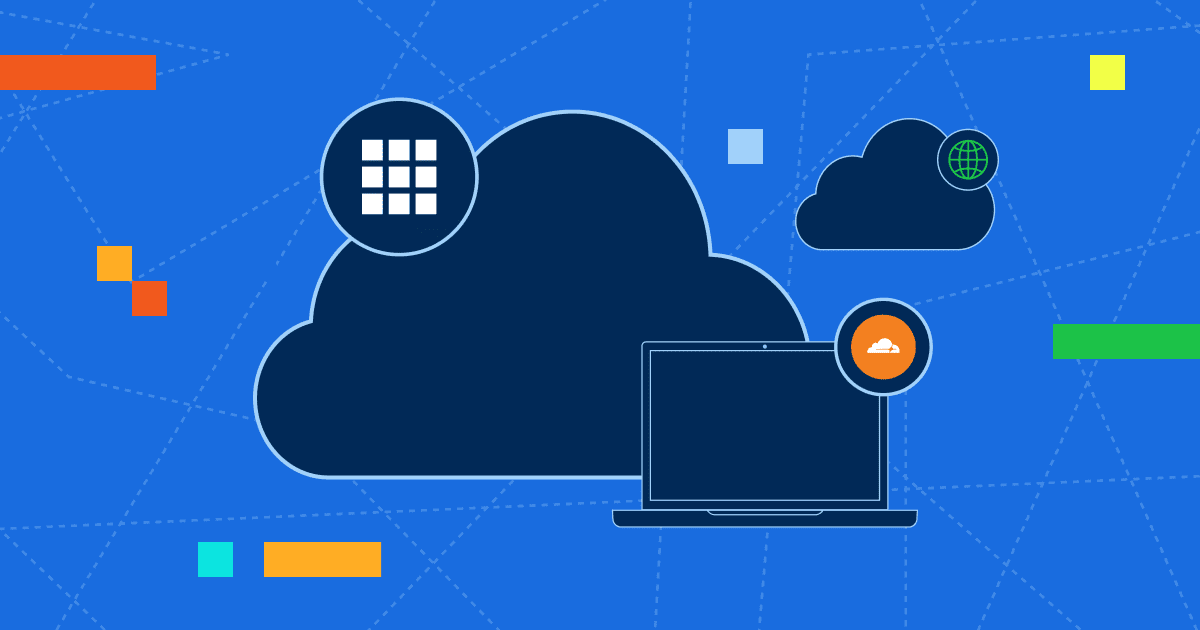
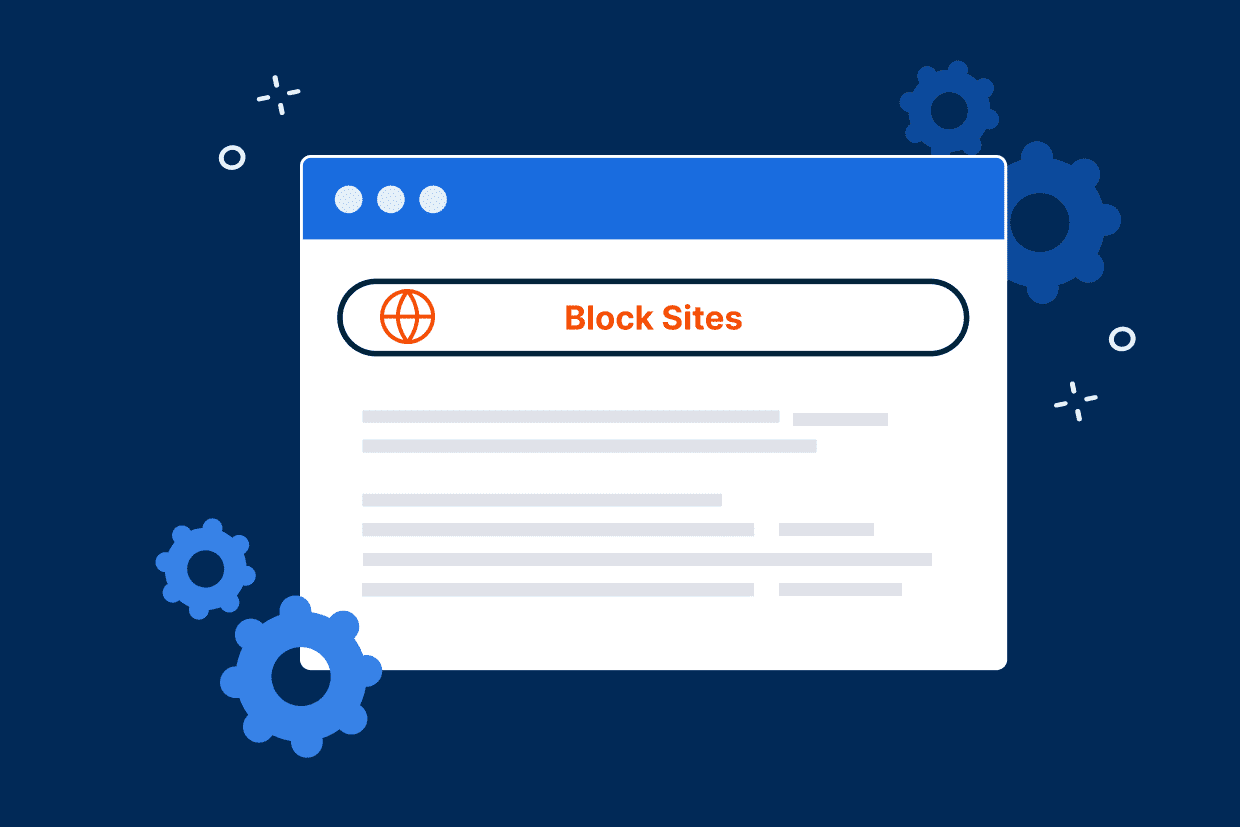

Write A Comment